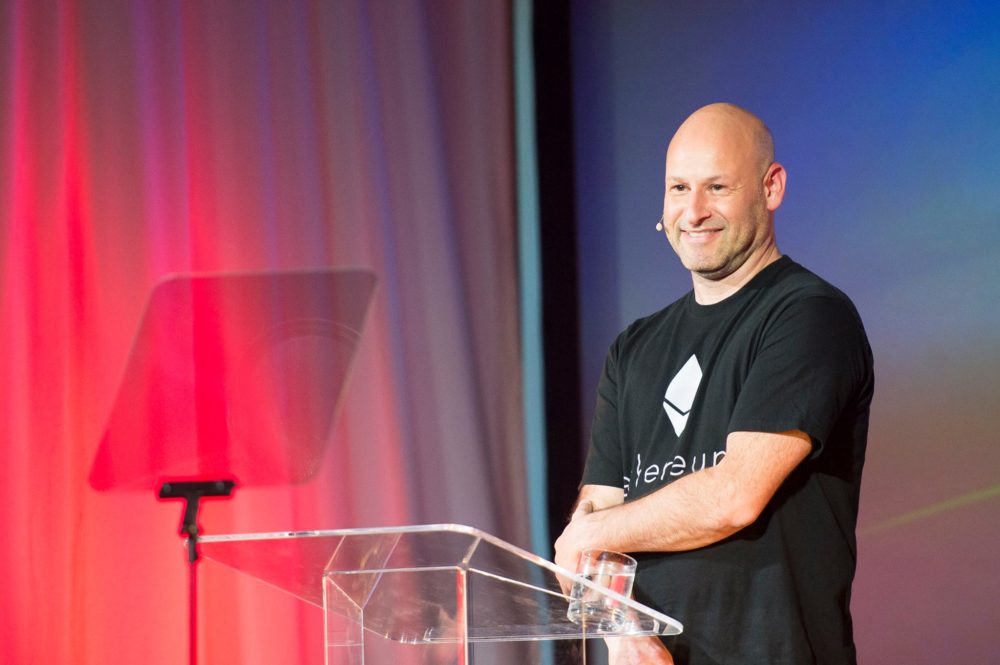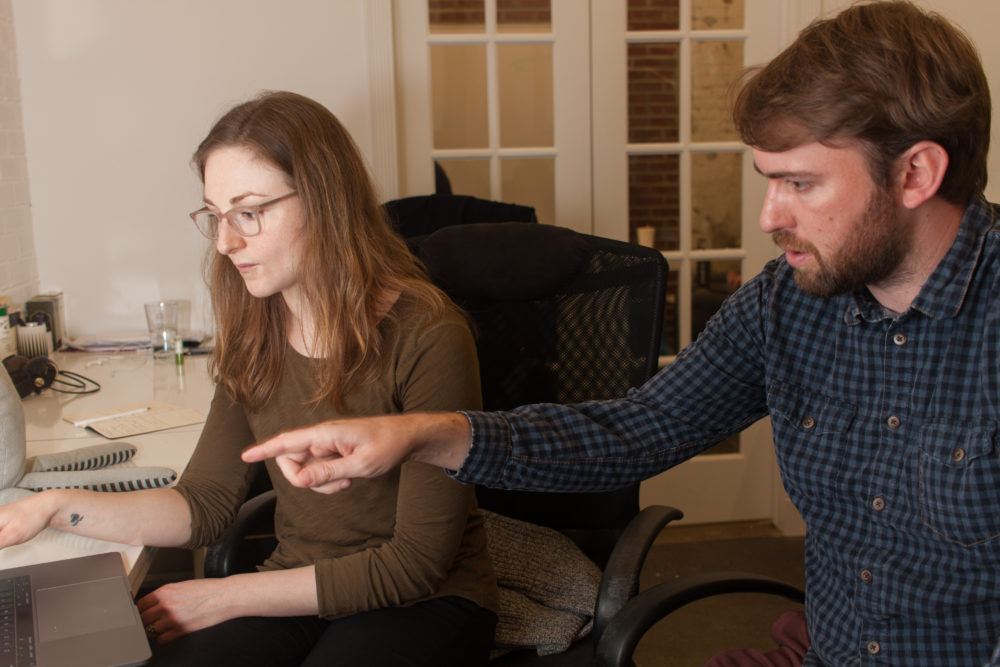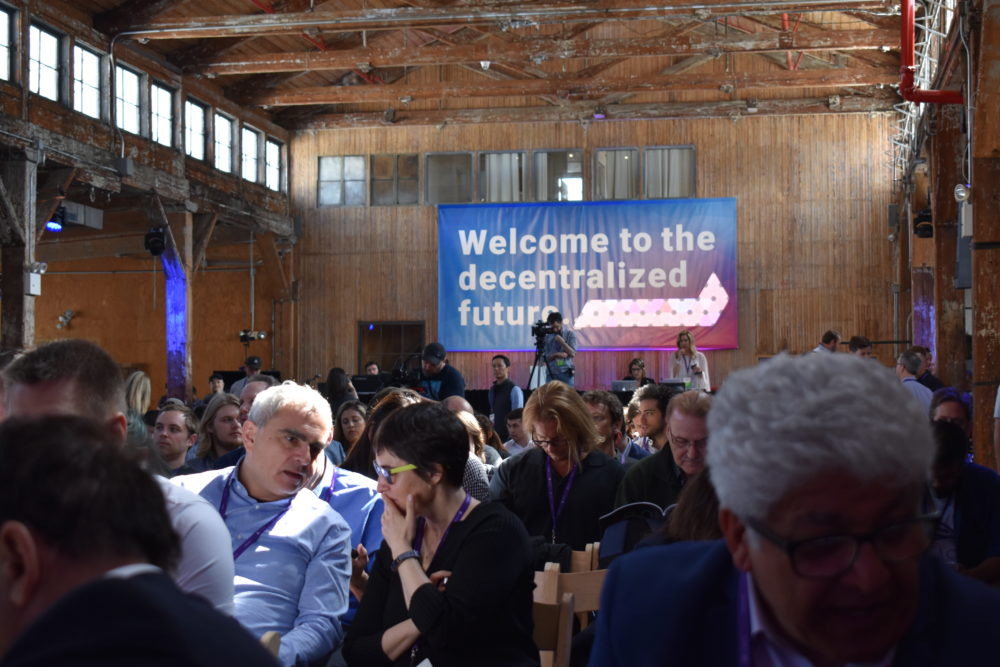How a Plan to Save Journalism Stumbled Out of the Gate
Brooklyn-based Civil tried a novel approach: cryptocurrency. But it failed to launch. Where does it go from here?
Matthew Iles, founder of Civil, which calls itself "the decentralized marketplace for sustainable journalism" (Photos courtesy of Civil)
Combining blockchain technology with a journalism platform, Brooklyn-based Civil has been one of the most talked-about startups in both worlds. Of all the schemes being hatched to shore up journalism with new business models, Civil’s idea was one of the most creative—perhaps inordinately so.
Last month was to be its launch, with a multimillion-dollar sale of the Bitcoin-like token, called CVL, that was predicted to serve manifold purposes including raising money, paying employees, and engaging readers. As it turned out, Civil’s cryptocurrency token sale ended on Oct. 10 with head-scratching failure. In the final days of the token sale, as money barely trickled in, the plan started to evaporate.
The company had set a minimum goal of $8 million for the sale to be a success. If the total were to fall below that level, all the money would be returned. Onlookers waited with interest to see if large donors would come in at the end and lift the company over the threshold. When the end of the day came, Civil had sold only about $1.4 million worth of CVL tokens. In the days that followed, it emerged that $1.1 million of that had come from the founder of its parent company, ConsenSys, meaning that after months of hype, planning, hiring, and hope, the CVL token was stillborn. But can Civil find another way to survive?
The Promise of a New Idea
Since its conception in August 2017, Civil caught the eye of those in journalism as a potentially useful new way to solve the intractable problem of the industry: how to get news readers to pay for what they read.
“The advertising market has just shrunk radically,” explained Sarah Bartlett, the dean of CUNY’s Craig Newmark Graduate School of Journalism. She said she has been following Civil and is intrigued by the project. “The print world has just collapsed and the revenue stream for digital news is still very limited. That’s the internet transformation we’ve seen over the last 20 years or so. Everyone can be a publisher on the internet and there’s a lot of free content out there. I think you’re seeing a move to people expecting to pay for quality news. You’re seeing that in publications that have strong brands, but you’re not seeing it at smaller places.”

The banner of the website Popula, one of Civil’s newsrooms
Civil has seemed to be offering some new thinking on that front, with its seed funding for small publications, plans for a platform of micro-payments, and reader direction in newsroom governance.
Founded by Matthew Iles, whose career had previously been in marketing, Civil aimed to create a payment platform on which readers could donate to their favorite publications with the CVL token. Readers could also use their tokens to have a voice in the governance and management of that publication, if the readers held a sufficient amount of CVL tokens.
“This was one of the most ambitious experiments aimed at creating a brand new model in journalism,” said Mathew Ingram, a writer on the topic of digital media for the Columbia Journalism Review. “Not just to charge readers, but to create a brand-new economic and journalistic platform,” he said. “They came up with a Civil constitution and an advisory council…and it wouldn’t be controlled by a company or a billionaire, it would be owned and controlled by token holders. That was a pretty radical way of looking at how to build a journalistic entity.”
Civil came about at a propitious moment in the life cycle of cryptocurrencies and blockchain technology. It was founded just as cryptocurrency values were headed for the stratosphere, when money and enthusiasm were abundant. Civil’s seed money of $2.5 million was invested by ConsenSys, the hyper-fast-growing developer of applications for the Ethereum blockchain platform.

Joseph Lubin, founder of ConsenSys, which has funded Civil with about $6 million (Photo courtesy of ConsenSys)
Based in a sticker and graffiti-covered brick building in East Williamsburg, ConsenSys was founded by the co-creator of Ethereum, Joseph Lubin, who is believed to be the single-largest holder of the Ethereum-based cryptocurrency, ether (ETH). In February, when ether was near its peak valuation, Forbes estimated his fortune at between $1 billion and $5 billion. But ether’s price has dropped 75% since then.
ConsenSys now employs more than 1,100 people around the world and has more than 50 portfolio companies, called “spokes” internally, all of which are paid for by ConsenSys. One of the main criticisms of ConsenSys, and of blockchain technology as a whole, is that it has yet to produce a useful application. With Civil, ConsenSys found a unique application, in journalism, to try out some of the asset-transfer features of blockchain technology. And, being in the journalism industry, it got a lot of press. (Editor’s note: the writer previously worked at OpenLaw, a ConsenSys portfolio company.)
“We didn’t get into this for any other reason than we think there’s an urgent problem facing the journalism world and, by extension, society, and we want to take a swing at something different,” Iles told The Bridge this week. “We’re emboldened by the community and the mostly positive reaction we’ve received.”
Last spring and summer, Civil went about funding startup newsrooms. The first one was called Popula, which produces articles about culture and politics, led by veteran reporter Maria Bustillos. Soon after came Sludge, a newsroom that tracks money in politics. At this point, at least 18 newsrooms run on the Civil platform. Fourteen of these newsrooms have been given cash grants by Civil, and all of them have received the rights to tokens.
Civil employs more than 20 people itself and the number of workers at its newsrooms reaches to 200. So far, Civil has raised $6 million from ConsenSys. In an interview, Iles declined to say when additional funding might come along, or its sources. The newsrooms are expected to produce their own revenue, in time, and some already have started to do so, from donations and other sources.
Problems With the Sale
Arguably the biggest story of the blockchain world in the last two years has been initial coin offerings (ICOs), also called token launches. In a token sale, a company creates a certain number of tokens and then sells those tokens around the world over the internet. The tokens can then be used to interact with that company’s product.
The more a company’s product is used by the public, the more valuable its token would become, the thinking goes. Since there are essentially no barriers on who can buy tokens, they open up a world of startup investing to everyday players, who otherwise face regulatory obstacles designed to protect small investors from getting burned by risky ventures.
In 2017, startup after startup raised major funding by offering tokens directly to the world. Filecoin, a company akin to Dropbox for the blockchain, raked in more than $250 million selling its token. A new blockchain protocol called Tezos raised more than $230 million. The list goes on. All this money raised the eyebrows of the Securities and Exchange Commission (SEC), which put a damper on ICOs in the U.S. when its chairman said in February that every ICO he’d seen looked like a security, meaning it would fall under the regulatory purview of the SEC.

Civil co-founders Julia Himmel, product designer, and Matt Coolidge, who focuses on brand strategy and communications (Photo courtesy of Civil)
It was in this environment that Civil chose to launch a token offering of its own. Its goal was to raise between $8 and $24 million through the sale of CVL. It would also comply with securities law, meaning that the token was not marketed as an investment, but rather as a useful key to be able to use for its intended purpose of supporting journalism.
The plan was to create 100 million CVL tokens. One third of them would be sold to the public, one third would be kept by Civil for distribution to its employees and future costs, and one third would be given to strategic partners, including the newsrooms on the platform. The tokens would be distributed to buyers in proportion to how much they pledged. Civil set a minimum threshold for the sale to be valid, similar to the way Kickstarter campaigns operate.
Prior to the sale, Civil hoped for a sale of between $8 and $24 million. At $24 million, each CVL token would come out to be worth about $0.70. At an $8 million raise, each token would be worth about $0.24.
Civil did not meet its minimum or anything close to it.
“This isn’t how we saw this going,” founder Iles wrote in a Medium post on the sale’s final day.
When the dust cleared, Civil received just $1.4 million. Since $1.1 of that came from Joe Lubin, the company by itself raised just $300,000 (this would have valued the CVL tokens at $0.008). The company has now returned the money to those who pledged.
Civil’s parent company, ConsenSys, has been quiet about the token sale. In the company’s monthly report for October, it mentioned only the number of Civil newsrooms and linked to one of the newsrooms’ podcasts about trusting yourself in startup-entrepreneurland.
When The Bridge asked ConsenSys’s chief strategy officer, Sam Cassatt, about the sale at a conference recently, the company’s marketing official accompanying him said it was time for lunch and all Civil questions would have to be directed to Civil.
According to Iles’ Medium post, the failed sale won’t put Civil under by any means. “We are backed by our investor, ConsenSys, and as a venture-backed, for-profit company, will likely continue to fund operations via equity investment until such time that we can sustain ourselves via commercial activity,” he wrote.
One of the problems that occurred during the sale was the difficulty users faced in participating. According to the NiemanLab at Harvard, there were 44 steps that needed to be taken to buy a CVL coin, due to the cumbersome nature of buying cryptocurrency and the steps necessary to have Civil’s bases covered with the SEC.
“You were required to study for and pass a test to show you understood Civil and cryptocurrency,” recalled Ethan Zuckerman, director of the Center for Civic Media at the MIT Media Lab. He participated in the token sale, attempting to buy about $70 worth of CVL because he thought it was an interesting new direction for journalism and he wanted to be a part of it, he said.

Said Iles in an interview: “This is what we signed up for and we’re not out of the first inning yet” (Photo courtesy of Civil)
“They pointed you towards various documents, videos and written documents. The quiz asks you what’s the difference between a hot wallet and a cold wallet and what it means if you don’t have sufficient gas to complete a transaction. I believe it was like half a dozen questions. A number of people mentioned that they’d taken it and failed it. It was not a gimme quiz.”
Zuckerman himself got stuck in the process but happens to be friends with Vivian Schiller, the chairman of the Civil Foundation, who helped get his purchase to go through.
Was CVL just too much of an awkward, in-between device? “The idea of this feature is that it would kind of undercut an argument that it’s a security because no one would purchase with a view to an investment if you have to actually use it,” explained a securities lawyer working in the blockchain space, who asked not to be named. “This is a new model [for ICOs]. Was it the structuring or the product itself? It’s really hard to raise $8 million. And it had to be from consumers. No big funds are going to want to go in. So now you’re at a place where it’s not really an investment and [as a pre-product sale] consumers aren’t really incentivized to buy it either. It’s a tough space to be in.”
“I think they overhyped demand and then smothered demand by making it really hard to buy [the tokens],” said CJR’s Ingram. “That might have been by design to keep out speculators, but I think it also kept out supporters. It was hugely overambitious and probably over-engineered. Eventually people just turn off. If you can give them a hundred bucks, great, but if you have to jump over these barriers …,” he said. “They at least started, or helped start, a bunch of newsrooms. That’s gotta be worth something. I think their heart’s in the right place.”
Not everyone agrees with that.
Internal Problems
“What is Civil doing that it offers to the world? And why is there a token? What does that do that a dollar can’t do? This is a whole stinking pile of shit,” said Daniel Sieberg, one of the earliest hires at Civil, who joined with a title of co-founder in November 2017. He was fired from the company in July of this year.
Sieberg, who had been a correspondent for CNN and CBS News and an executive at Google, said he became disillusioned by the product Civil was building over the summer—and by the constant delays.
“The doublespeak, the Orwellian-ness of this. Coming soon? What’s coming soon? I don’t know how anyone can look at this and think it was anything other than a massive failure or a massive fraud,” he said. “If I had a bitcoin for every time I heard ‘Coming soon,’ I would actually be a millionaire.”
In an interview, Iles and cofounder Matthew Coolidge bridled at the allegation of any deception.
“To suggest that Civil is a fraud is borderline slanderous,” Coolidge said. “We’re not. We’re 24 people that are working our tails off to try to make this a reality. This is not any kind of get-rich-quick scheme and there are warts and all, and obviously there have been plenty of warts. But I draw the line at fraudulence.”

A scene from this year’s Ethereal Summit, where blockchain aficionados gather to talk about the technology’s potential uses (Photo by Steve Koepp)
“I strongly refute questioning the integrity of the project,” added Iles. “You could say ‘I don’t think this is a good idea’ and ‘I don’t think someone should pay for this’ but I do not think Civil is a fraud.”
Another angry former employee spoke up this week. Jay Cassano worked at the Civil newsroom Sludge until this month. He told The Bridge that he was paid in part in promises of CVL tokens, which he said Civil brass led him to believe would be worth around $0.75 each.
When he joined the company, in March, Cassano was offered several packages with various proportions of money and future CVL tokens. Cassano said he was pressured to take a package with a higher percentage of tokens, which meant he made very little money for the first four months he was there, during which time he took on debt to get by.
“At that point, Civil was saying that the token sale would happen in May and the platform would launch in June,” Cassano said this week. “After a few months Civil realized they were completely out of their depth and they were trying to build a new [content-management system] from scratch and decided they would launch all their publications on WordPress and that the technology they would deliver would actually be WordPress plug-ins.” (WordPress is the workhorse of content-management systems, running tens of millions of websites, including The Bridge.)
“That was sort of the first alarm bell and some reporters were concerned by that because it showed that there wasn’t going to be that much technology differentiation,” said Cassano, “and it also showed a level of incompetence that they spent all this time building a platform they threw out for this WordPress. They kept pushing things back and still are.”
Cassano acknowledged that after his first five months on the job under his initial contract, he signed a new, more conventional agreement, in which he got paid fully in dollars at a competitive salary.
His boss at Sludge, David Moore, disputes the idea that Civil implied the tokens would be worth a certain value.
“The newsrooms had good communications and clarity from Civil that this was a new consumer token and it would come with all these restrictions,” Moore explained. “The token had so many regulations around it … that we weren’t expecting the token to be dollar-valued initially.”
“It’s hard to describe this without sounding bearish,” Moore said, “but we were expecting our newsroom to be primarily sustained through fiat [currency] donations, collected through Stripe. I can be quite direct and forthright that there were no representations from Civil of a price floor. We knew the token would be volatile and could be valued in the markets at low rates.”
Another reporter, who remains employed in a Civil newsroom and asked not to be named, noted that salaries are on the whole quite good for reporters at Civil, but agreed that the company gave a rosy impression about the sale.
“My recollection is on group calls or conference calls that there was the impression that the tokens would be [worth] around 75 cents or a dollar or even up to $3 or $4,” the Civil journalist said.
Another journalist, also still at a Civil newsroom, agreed there was talk of the tokens being worth in the $0.75 to $1 range, but said that the estimates were based on hope, not on dishonesty.
“Startup publications are always in danger of folding, that’s kind of the caveat emptor of this industry. They have some money here and are trying something and paying you to write. I didn’t take this job thinking these tokens were something I could count on being worth a lot,” the reporter said.
What Is Civil’s Future?
Iles said Civil won’t do another token sale. “We’re not quite ready to speak in much detail about what comes next. What we are definitely not doing is what we did before,” he said. “Tokens are very much a part of our future. What we’re not doing is a token sale in the kind we did last time, with a soft cap and a hard cap.”
People remain interested.
“I was and I remain very intrigued by it,” said the Newmark school’s Bartlett. “I think the blockchain technology offers some really interesting opportunities for journalism, so I like that there are people trying to experiment with that… I think they’ve attracted really smart people, so there’s a lot of talent in their content production. Those are good people with good ideas, so to see capital being used for those purposes makes me happy.”
At Sludge, Moore’s seed funding from Civil is set to end in March, a year after he brought the newsroom online. He said his team will continue to raise money in other ways to keep it running, including crowdfunding, through partnerships and collaborations with other publications, even from an eventual token sale.
“There’s going to have to be a new plan for getting these tokens out into people’s hands and there’s more to come on that,” he said. “We’ll continue to build our base of donors and be a pioneer so that when people can touch the tokens on our website they will hopefully see that this is a different experience and it gives them a say on the governance of the platform, it gives them a say on the ethics of the newsroom. When more people have CVL tokens in a wallet and can conduct transactions on the site, we think we can generate more partnerships with other newsrooms. It will be different than just setting up a WordPress site, setting up a Mailchimp and setting up a Patreon.”
Iles says a new plan is coming soon.
“This is what we signed up for and we’re not out of the first inning yet. If you think this is stressful, wait till we get out of this and start taking on the incumbents. We’re not even born yet.”













